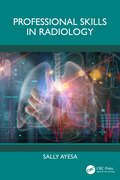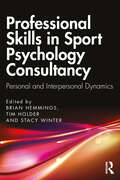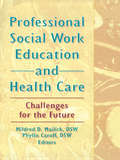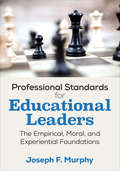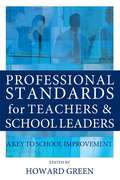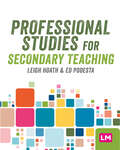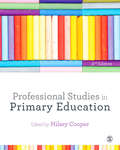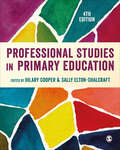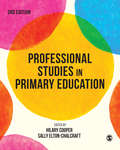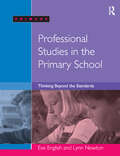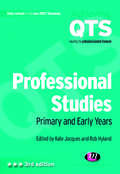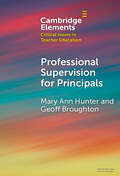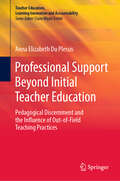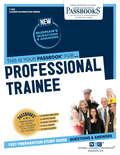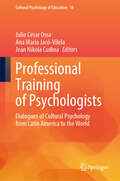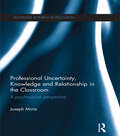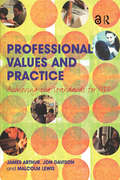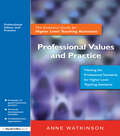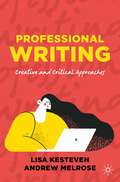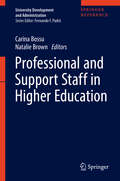- Table View
- List View
Professional Skills in Radiology
by Sally AyesaPracticing as a radiologist is about more than image interpretation. Professional Skills in Radiology provides a concise handbook of essential non-interpretative skills a medical imaging doctor should possess. The book explores important professional development skills needed to work with diagnostic and procedural radiology patients, within healthcare multidisciplinary teams and in the community. It also provides a resource to bring together important concepts in evidence-based practice, research and quality assurance, medical education, advocacy and ethical practice, and cultural safety. Professional Skills in Radiology will be an excellent companion resource for training and consultant radiologists, containing practice questions to help prepare for fellowship/board examinations or interview panels.
Professional Skills in Sport Psychology Consultancy: Personal and Interpersonal Dynamics
by Brian Hemmings Tim Holder Stacy WinterProfessional Skills in Sport Psychology Consultancy raises awareness of intrapersonal and interpersonal professional practice skills. The book chapters focus on the aspiring practitioner’s personal and professional development when working with all kinds of recipients of psychological support in sport including individual athletes, teams, coaches, parents, and administrators.Organized in two sections – intrapersonal processes and interpersonal dynamics – this new book steers readers through the many subtle and complex factors that impact on the professional relationships that ultimately influence successful outcomes and provides guidance for students, researchers, and practitioners about the many intrapersonal and interpersonal processes involved in the working alliance, professional relationship, and sport psychology consultancy.Professional Skills in Sport Psychology Consultancy is a core text for upper-level undergraduate and postgraduate sport psychology students, sport psychologists undergoing professional training, and early career sport psychologists.
Professional Social Work Education and Health Care: Challenges for the Future
by Mildred D Mailick Phyllis CaroffProfessional Social Work Education and Health Care responds to critical concerns about the educational preparation of social workers within the rapidly changing health care environment. Contributors address issues and questions of importance to educators who are contending with the multiple challenges of rapidly changing institutions, fiscal constraints, and service to populations with complex social health care needs. This coverage provides you with important visions of the future education of leaders in health care social work. The editors of Professional Social Work Education and Health Care present information that looks to the future in order to open the floor for communication among the leaders in health care social work settings. Chapters explain the context of social work practice, exploe current social work practice issues, and look into continuing education and fieldwork. In doing so, they give you valuable information about imprtant issues such as: changes in social work department structure and function in challenging economic times collaborative efforts and reciprocal relationships in education and training emergence of networks that will join forces with hospitals preparation for short-term, solution-based social work the remaining need for traditional, long-term social work frameworks and values the shift in ideology to viewing clients as consumers rather than patients modification of curriculum to focus on parenting, health education, adolescent pregnancy prevention, and wellness programs emergence of a model for post-master’s education field work in community-based health care placements versus inpatient hospital settingsThis book’s model for making education and practice responsive to each other and for responding to the needs for collaboration makes it a valuable resource for social work educators, practitioners, and clinicians in health and mental health; advanced gerontologists in academic and practice agencies; and teachers of policy and research in health concentrations in schools of social work. Professional Social Work Education and Health Care is an excellent ancillary text for advanced undergraduate and graduate courses in social work practice in health and mental health and is a strong addition to reading lists for classes on social work with the aged, social work research in health care, and field work seminars in health and mental health.
Professional Standards for Educational Leaders: The Empirical, Moral, and Experiential Foundations
by Joseph F. MurphyUnpack the standards and build a plan for leading learning Professional Standards for Educational Leaders introduces the foundations of the recently revised professional educational leadership standards and provides an in-depth explanation and application of each one. Written by the primary architect of PSEL, educational leadership expert Joseph F. Murphy, this authoritative guide to understanding and applying the standards explores the new emphasis on: Leadership of learning, school culture, and diversity Values, ethics, and professional norms of educational leadership Teacher quality, instruction, and caring support Written for higher education faculty, professional development providers, and school and district leaders, the author truly brings the standards to life. This comprehensive manual will power the educational leadership profession through the challenges of the next decade and beyond. "Murphy offers an exploration of the kind of leadership that matters most for each and every student. Let us hope the thinking reflected in this book and the new PSEL standards redirects our attention to what it really means to lead in education." Michelle D. Young, UCEA Executive Director, Professor of Leadership University of Virginia "Joseph Murphy debunks myths about standards for educational leaders and skillfully unpacks the moral, foundational, and experiential basis for the revised professional standards to guide effective leadership of our nation’s schools. This book is a must read for those interested in leadership for learning and the academic success and wellbeing of students, because these standards will shape our field for the next quarter century as the ISLLC standards have done since 1996." Martha McCarthy, Presidential Professor Loyola Marymount University
Professional Standards for Educational Leaders: The Empirical, Moral, and Experiential Foundations
by Joseph F. MurphyUnpack the standards and build a plan for leading learning Professional Standards for Educational Leaders introduces the foundations of the recently revised professional educational leadership standards and provides an in-depth explanation and application of each one. Written by the primary architect of PSEL, educational leadership expert Joseph F. Murphy, this authoritative guide to understanding and applying the standards explores the new emphasis on: Leadership of learning, school culture, and diversity Values, ethics, and professional norms of educational leadership Teacher quality, instruction, and caring support Written for higher education faculty, professional development providers, and school and district leaders, the author truly brings the standards to life. This comprehensive manual will power the educational leadership profession through the challenges of the next decade and beyond. "Murphy offers an exploration of the kind of leadership that matters most for each and every student. Let us hope the thinking reflected in this book and the new PSEL standards redirects our attention to what it really means to lead in education." Michelle D. Young, UCEA Executive Director, Professor of Leadership University of Virginia "Joseph Murphy debunks myths about standards for educational leaders and skillfully unpacks the moral, foundational, and experiential basis for the revised professional standards to guide effective leadership of our nation’s schools. This book is a must read for those interested in leadership for learning and the academic success and wellbeing of students, because these standards will shape our field for the next quarter century as the ISLLC standards have done since 1996." Martha McCarthy, Presidential Professor Loyola Marymount University
Professional Standards for Teachers and School Leaders: A Key to School Improvement
by Howard GreenWhat do the professional standards mean for teachers and school leaders? Everyone working in education needs a clear understanding of the professional standards required of teachers and school leaders. Written by a team of expert and well-respected contributors, this book provides the definitive guide to the standards that are now widely used for initial teacher training, induction, continuing professional development and performance management. In addition it covers the standards for subject leaders, which underpin the national programme for subject leaders, and the standards for headteachers, which are now used as an essential requirement for headship. The main element of each of the standards reflects the broad dimensions of teaching and leadership, covering everything from planning and assessing learning to relations with the wider community and managing one's own performance and development. Clearly explaining the nature of the standards the writers demonstrate how they relate to the real world of teaching and leadership and point out key issues for the future. The final chapters of the book set the application of standards into a more critical framework and suggest how the standards can meet future as well as current needs.
Professional Studies for Secondary Teaching
by Ed Podesta Leigh Hoath*A core text for the Professional Studies module linked to the CCF. *Supports trainees to develop their knowledge, understand their role as a professional and to engage with practice and theory. *Each chapter outlines the topic, describes any debates or alternate perspectives and suggests further reading or study. *Readers are supported with ideas for reflection, learning activities, assignment support. *The book enables a clear intent and a structured implementation of a professional studies curriculum.
Professional Studies for Secondary Teaching
by Ed Podesta Leigh Hoath*A core text for the Professional Studies module linked to the CCF. *Supports trainees to develop their knowledge, understand their role as a professional and to engage with practice and theory. *Each chapter outlines the topic, describes any debates or alternate perspectives and suggests further reading or study. *Readers are supported with ideas for reflection, learning activities, assignment support. *The book enables a clear intent and a structured implementation of a professional studies curriculum.
Professional Studies in Primary Education
by Hilary CooperThis textbook provides a wide-ranging overview of everything you will need to know to prepare you for initial teacher training and your early career in the primary classroom. Covering practical issues including planning, assessment and classroom organisation, and thought-provoking topics such as reflecting on your own teaching practice and developing critical thinking skills, this textbook gives you a pragmatic and insightful understanding of teaching in primary schools. Key new edition features: Updated coverage of education policy Links to the Teachers' Standards A new Work in Schools feature addressing key issues student teachers encounter Extended coverage of planning and assessment A new chapter on workplace learning exploring how to develop as a classroom professional Coverage of differences in teaching throughout the UK. This is essential reading for all students on primary initial teacher education courses including university-based (PGCE, Bed, BA with QTS), and schools-based (School Direct, SCITT) routes into teaching. Additional online resources at www.uk.sagepub.com/cooper There are also updated free resources supporting and extending chapters, including activities, case studies, further reading and useful web links. Hilary Cooper is Professor Emeritus of History and Pedagogy at the University of Cumbria.
Professional Studies in Primary Education
by Hilary Cooper Sally Elton-ChalcraftThis textbook gives you a broad overview of everything you will need to know to prepare for your initial teacher training and future career in the classroom. Covering practical issues including planning and assessment, and thought-provoking topics such as reflecting on your practice and developing critical thinking skills, this textbook provides you with an insightful exploration of the realities of teaching in primary schools. This fourth edition has been comprehensively revised and includes five new chapters on: · Teacher wellbeing · The Early Career Framework (ECF) · Digital literacy and primary schools after the pandemic · Growth mindset, dialogue and P4C · Learning outside the classroom This is essential reading for all students on primary initial teacher education courses including university-based (PGCE, BEd, BA with QTS), and schools-based (School Direct, SCITT, Teach First) routes into teaching. Hilary Cooper is Professor Emeritus of History and Pedagogy at the University of Cumbria. Sally Elton-Chalcraft is Professor of Social Justice in Education and also the Director of the Learning Education and Development Research centre in the Institute of Education at the University of Cumbria.
Professional Studies in Primary Education
by Hilary Cooper Sally Elton-ChalcraftThis textbook gives you a broad overview of everything you will need to know to prepare for your initial teacher training and future career in the classroom. Covering practical issues including planning and assessment, and thought-provoking topics such as reflecting on your practice and developing critical thinking skills, this textbook provides you with an insightful exploration of the realities of teaching in primary schools. This fourth edition has been comprehensively revised and includes five new chapters on: · Teacher wellbeing · The Early Career Framework (ECF) · Digital literacy and primary schools after the pandemic · Growth mindset, dialogue and P4C · Learning outside the classroom This is essential reading for all students on primary initial teacher education courses including university-based (PGCE, BEd, BA with QTS), and schools-based (School Direct, SCITT, Teach First) routes into teaching. Hilary Cooper is Professor Emeritus of History and Pedagogy at the University of Cumbria. Sally Elton-Chalcraft is Professor of Social Justice in Education and also the Director of the Learning Education and Development Research centre in the Institute of Education at the University of Cumbria.
Professional Studies in Primary Education
by Professor Hilary Cooper Sally Elton-ChalcraftThis textbook provides a wide-ranging overview of everything you will need to know to prepare you for initial teacher training and your early career in the primary classroom. Covering practical issues including planning, assessment and classroom organisation, and thought-provoking topics such as reflecting on your own teaching practice and developing critical thinking skills, this textbook gives you a pragmatic and insightful understanding of teaching in primary schools. This third edition has been comprehensively revised to include new chapters on: Personal, social, health and economic education (PSHE) Safeguarding and your responsibilities Teaching EAL learners Behaviour management and encouraging behaviour for learning Inclusion and special educational needs, including the 2015 SEND Code of Practice Critical perspectives on fundamental British values Moving on to Master’s level study This is essential reading for all students on primary initial teacher education courses including university-based (PGCE, BEd, BA with QTS), and schools-based (School Direct, SCITT, Teach First) routes into teaching.
Professional Studies in Primary Education
by Professor Hilary Cooper Sally Elton-ChalcraftThis textbook provides a wide-ranging overview of everything you will need to know to prepare you for initial teacher training and your early career in the primary classroom. Covering practical issues including planning, assessment and classroom organisation, and thought-provoking topics such as reflecting on your own teaching practice and developing critical thinking skills, this textbook gives you a pragmatic and insightful understanding of teaching in primary schools. This third edition has been comprehensively revised to include new chapters on: Personal, social, health and economic education (PSHE) Safeguarding and your responsibilities Teaching EAL learners Behaviour management and encouraging behaviour for learning Inclusion and special educational needs, including the 2015 SEND Code of Practice Critical perspectives on fundamental British values Moving on to Master’s level study This is essential reading for all students on primary initial teacher education courses including university-based (PGCE, BEd, BA with QTS), and schools-based (School Direct, SCITT, Teach First) routes into teaching.
Professional Studies in Primary Education (Second Edition)
by Hilary CooperDeveloping an understanding of the professional aspects of teaching is an integral part of training to teach in primary education, and requires a broad and deep engagement with a wide number of practical and theoretical issues. Professional Studies in Primary Education provides a wide-ranging overview of everything you will need to know to prepare you for your primary initial teacher education course, and your early career in the classroom. Covering practical issues including behaviour management and classroom organisation, through to thought-provoking topics such as reflecting on your own teaching practice and developing critical thinking skills in the classroom, this textbook offers a modern and insightful exploration of the realities of teaching in primary education today. This approach is supported by: An awareness of current policy developments and statutory requirements Examining complex, multi-faceted issues in education Exploring alternative approaches to primary teaching practice Investigating ways to encourage personal and professional development as a teacher. Additional online resources at www.uk.sagepub.com/cooper There are also free companion resources supporting and extending chapters, including activities, case studies, further reading and useful web links. This is essential reading for all students on primary initial teacher education courses including undergraduate (BEd, BA with QTS), postgraduate (PGCE, SCITT), and employment-based routes into teaching. Hilary Cooper is Professor of History and Pedagogy at the University of Cumbria
Professional Studies in the Primary School: Thinking Beyond the Standards
by Eve English Lynn NewtonFull of school-based examples supplied by practicing teachers, this accessible text: encourages trainees to "think beyond the standards" promotes the development of reflective, creative and imaginative teaching skills links theory with practice to show students how to apply these skills leads the reader through the key issues and concepts in general professional practice. Written specifically for Professional Studies modules in primary education, this book will guide trainees in the early stages of their careers to become the imaginative teachers we need in our primary schools.
Professional Studies: Primary And Early Years (Achieving QTS Series)
by Kate Jacques Rob HylandThis key resource for trainee primary teachers helps them to understand and fulfil the new professional requirements for QTS. It focuses on a range of professional issues – including management of pupils' work, individual needs and equal opportunities, behaviour for learning and professional responsibilities outside teaching. Each chapter includes tasks, examples and further reading to highlight important concepts and key issues. New and revised chapters mean this third edition is up to date with the QTS Standards, latest documents and initiatives. Further, new reflective tasks and Moving On sections help trainees to build on the information in each chapter.
Professional Supervision for Principals: A Primer for Emerging Practice (Elements in Critical Issues in Teacher Education)
by Mary Ann Hunter Geoffrey BroughtonSchool leaders work in increasingly complex systems. Alongside leading learning, they daily navigate the needs and expectations of educational departments, teachers, students, parents, society, and themselves. Leadership can therefore be a dynamic vocational calling, but studies show that principals' professional agency, career sustainability, and wellbeing are diminishing. This Element brings a fresh perspective to how educational leaders can be better served and supported by collaborative, co-agentic partnerships at this time. It makes the case for professional supervision, a practice commonplace in clinical and pastoral professions that offers facilitated, action-oriented attention to the interplay of role, 'soul', and context. As a practice-based primer, this Element reclaims supervision against outdated associations with performance management by drawing on interdisciplinary research and the authors' own experience as supervisor partners with principals. It proposes a new schema of professional supervision in education informed by curiosity, unlearning, resonance, and attunement in a rapidly changing world.
Professional Support Beyond Initial Teacher Education: Pedagogical Discernment and the Influence of Out-of-Field Teaching Practices (Teacher Education, Learning Innovation and Accountability)
by Anna Elizabeth Du PlessisThis book investigates the professional learning needs of teachers beyond initial teacher education, focusing on teachers in complex teaching positions, such as out-of-field teaching practices. The information presented here will help to improve professional learning strategies, while also offering an in-depth understanding of teachers’ needs, leaders’ perceptions, and what complex teaching situations mean for teachers’ professional learning and development. Further, Du Plessis shares the perceptions and lived experiences of teachers, parents, leaders and students as key stakeholders in quality teaching and learning environments.In light of new evidence-informed findings on the out-of-field phenomenon and continuing professional learning, Du Plessis puts forward strategies that will enhance the effectiveness of professional learning and development programs, while also fostering improved decision-making and policy development. In brief, Du Plessis focuses on the impact that complex teaching situations have on teachers’ unique needs, the support that is provided, and the influence of the out-of-field phenomenon on teachers’ responses to continuing professional learning and development programs.
Professional Trainee: Passbooks Study Guide (Career Examination Series)
by National Learning CorporationThe Professional Trainee Passbook® prepares you for your test by allowing you to take practice exams in the subjects you need to study. It provides hundreds of questions and answers in the areas that will likely be covered on your upcoming exam, including but not limited to: understanding and interpreting written material; mechanical aptitude; arithmetic; preparing written material; word meaning; verbal abilities; interpreting statistical data in graphs, charts and tables; reading comprehension; and other related areas.
Professional Training of Psychologists: Dialogues of Cultural Psychology from Latin America to the World (Cultural Psychology of Education #18)
by Julio César Ossa Ana Maria Jacó-Vilela Jean Nikola CudinaThis book represents an intellectual journey through the history, culture, and training of psychologists in Latin America to transcend borders. It analyzes the inception of academic programs in each country in the region, exploring the socio-political and economic context, and delves into the conceptual, methodological, and epistemological aspects of training. Similarly, it discusses how psychology prepares professionals for their roles in society and provides updated data on the discipline's growth in the region. Furthermore, it promotes international and intercultural dialogue, enriching the global understanding of psychology. The book's emphasis on adopting a historical and cultural approach is essentially an effort to introduce a critical component to the analysis of psychologist professional training. This component adds value for the reader and aids in understanding how Latin American psychology has been shaped by historical events, social movements, government policies,and the diverse cultural traditions of the region. Readers will gain a profound understanding of why psychology has developed in a particular way in each Latin American country, shedding light on significant variations in psychological practice and theory in this part of the world. Essentially, this work constitutes an invaluable resource for academics, professionals, and anyone interested in understanding the intersection between psychology and the rich historical and cultural diversity of Latin America.
Professional Uncertainty, Knowledge and Relationship in the Classroom: A psychosocial perspective (Routledge Research in Education)
by Joseph MintzThe extent to which teachers should make use of theoretical and expert knowledge as opposed to tacit experiential knowledge, and how these might be combined, is a perennial issue in discussions on pedagogy. This book addresses these debates through a creative development of the concept of productive uncertainty.Using case studies focusing on teachers working with children with autism, a particularly fertile crucible for considering uncertainty, the book explores how the radical 20th century psychoanalyst Wilfred Bion's epistemological approach to uncertainty can be used to re-frame Donald Schön's concept of reflection in action, offering a new perspective on the practice of teachers and other caring professionals. Several areas of potential uncertainty are identified, including uncertainty relating to areas of practice including diagnosis, the relationship between expert knowledge and practice, the implications of autism for autonomy and agency, and uncertainties in relation to the understanding of and use of new technologies. A strong argument is made, based on both theoretical and empirical grounds, that in juggling between theoretical and tacit knowledge in the classroom there is more to be gained by staying with the struggle with uncertainty than by fleeing from it too early, into the promise of expert solutions. Consideration is also given to the relative importance of specific theoretical training for teachers, both in general and in relation to working with children with special educational needs, in the context of international and UK policy developments in this area.This book will be of key value to researchers and postgraduates in the fields of education studies, teacher thinking and research, psychoanalytically informed psychosocial studies, as well as to practitioners working in special educational needs/autism education.
Professional Values and Practice: Achieving the Standards for QTS
by James Arthur Jon Davison Malcolm LewisThe professional code of the General Teaching Council lists eight new standards, each of them analysed here in detail using questions and activities to describe what trainee teachers need to know, understand and demonstrate as they work towards Qualified Teacher Status. Each of the eight standards cover the following issues: expectations, diversity and achievement personal and professional values values in the classroom values, rights and responsibilities in the wider community the community of the school professional relationships personal and professional development professional responsibility. This practical and jargon-free guide features an extensive range of examples and suggestions for further reading, designed to help those in their early professional development.
Professional Values and Practice: The Essential Guide for Higher Level Teaching Assistants
by Anne WatkinsonProfessional Values and Practice concentrates on the more theoretical aspects of the HLTA role: professionalism, relationships, statutory frameworks and knowing your limits. It offers guidance and support on fulfilling the standards and succeeding both inside and outside of the classroom. This book provides: real-life case studies that put the theory behind the standards into a whole-school context practical activities that convey how the standards can be used in the classroom guidance on the school-based aspects of the training and assessment advice on the difference between the learning and teaching standards for newly qualified teachers and HLTAs. This book is complemented by a companion volume, Learning and Teaching, which underpins the practical teaching skills required of teaching assistants at this level.
Professional Writing: Creative and Critical Approaches
by Andrew Melrose Lisa KestevenThis book has been designed specifically for students in writing classes and other writers interested in developing proficient writing careers in a professional environment. As professional writing continues to change rapidly alongside digital developments, this book frames professional writing particularly for 'creative' and other writers. The professional world needs writers with a diverse portfolio of skills and capabilities; if writers can master these, they are more able to make a living from their writing and support their more creative endeavours. Each chapter includes a comprehensive range of exercises to build professional skills, along with learning objectives, case studies, worked examples, tips for success, and suggested websites and further reading.
Professional and Support Staff in Higher Education (University Development And Administration Ser.)
by Natalie Brown Carina BossuThis volume, Professional and Support Staff in Higher Education, is focused on the issues and experiences of professional and support staff in higher education. The 29 chapters of this book span a broad range of topic areas, ranging across professional practices and identity, leadership and inclusion in higher education, professional development, and how the current higher education landscape impacts on their work, careers, aspirations and performance. The broad aims of this book are twofold: to contribute to the limited body of knowledge regarding professional and support staff in higher education, and to explore the key issues facing these professionals today through their own contributions.Professional and support staff are one of the universities’ most valuable assets, as they hold much of the corporate knowledge required to ensure that universities operate efficiently and effectively. The increasing professionalization of university professional staff has impacted on the roles they currently perform, as more professionals now occupy senior executive positions within universities; positions there were previously occupied by senior academics. Similarly, the boundaries between some professional and academic roles have blurred, creating a sub-category; the para-academic staff. Given the contribution professional and support staff make, and the increasing importance of the roles they perform within their institutions and to the society as a whole, it is surprising that their work, impact, careers, and aspirations remain largely unexplored in the literature and research to date. We hope readers find this book useful and insightful, that it enables greater and deeper insight among and between professional staff and their institutions, and that it contributes meaningfully to the growing body of knowledge and scholarship regarding professional and support staff in higher education globally. We also hope that the book assists in raising awareness about the professions that are part of our educational institutions, and the contributions that they make not only to their organisations, but to society as a whole.
